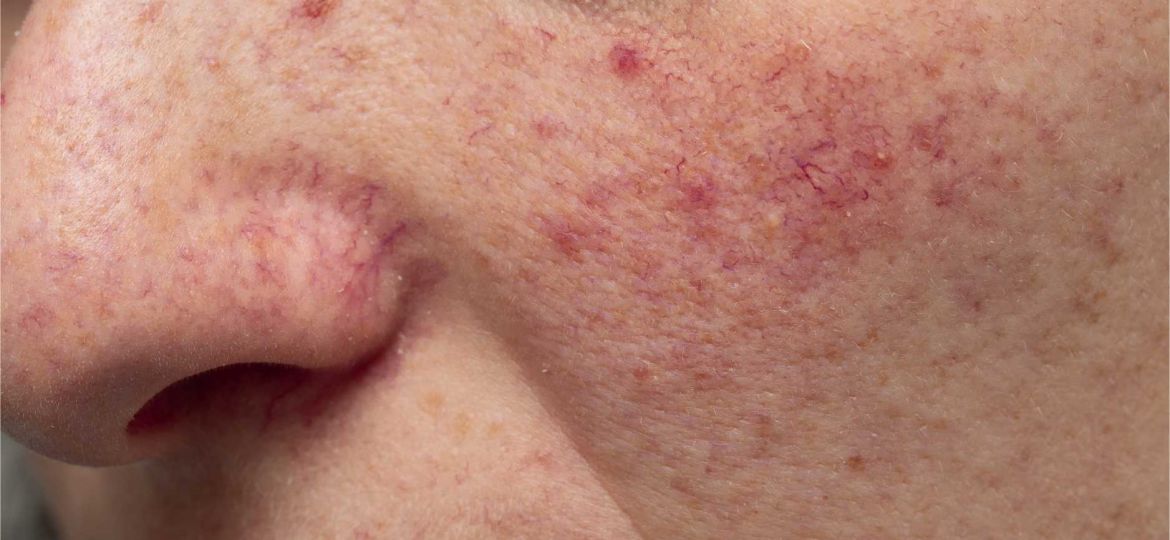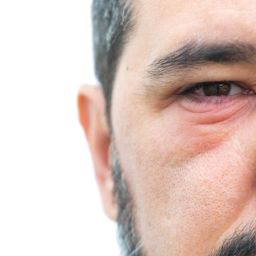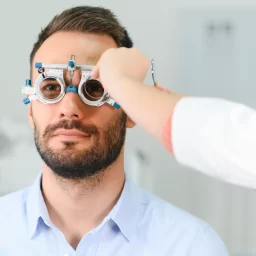
As June, the National Acne Awareness Month, ushers in a focus on skin health, it’s the perfect time to discuss the intricacies and overlaps between two commonly misunderstood conditions: acne and rosacea. At The Dry Eye Center of Maryland, we dive deep into these issues, particularly highlighting ocular rosacea, a significant yet often overlooked facet of rosacea.
Rosacea: More Than Skin Deep
Affecting at least 16 million Americans, rosacea is a chronic inflammatory skin condition noted for its redness, flushing, and visible blood vessels, primarily on the face. It can cause bumps and thickened skin, significantly impacting one’s self-esteem and social interactions. Not just a surface issue, rosacea is a systemic disorder linked to genetics, immune dysfunction, and environmental factors, demanding ongoing management strategies to mitigate its effects.
The Four Faces of Rosacea
Rosacea manifests in several subtypes, each with distinct symptoms:
- Erythematotelangiectatic Rosacea (ETR): Characterized by facial redness, flushing, and visible blood vessels.
- Papulopustular Rosacea (PPR): Often referred to as acne rosacea due to its acne-like breakouts.
- Ocular Rosacea: Affects the eyes and eyelids, potentially leading to watery, bloodshot eyes, and a feeling of something in the eye.
- Phymatous Rosacea: Involves thickening of the skin and is less common.
Acne vs. Rosacea: Understanding the Differences
While rosacea and acne can appear similar, especially in the papulopustular subtype, there are key differences. Acne is typically linked to oil production and clogged pores, featuring blackheads and whiteheads which are not symptoms of rosacea. On the other hand, rosacea is tied to vascular and inflammatory pathways and does not feature comedones (blackheads and whiteheads).
Ocular Rosacea: The Eye’s Cry for Help
Ocular rosacea is particularly challenging as it often precedes skin symptoms. Symptoms include:
- Persistent eye redness
- Wateriness or dryness
- Feeling of grittiness
- Sensitivity to light
- Visible blood vessels on the eyelids
Demystifying the Causes of Rosacea
The exact causes of rosacea are multifaceted, involving genetic predisposition, environmental triggers like sun exposure and stress, immune dysregulation, vascular abnormalities, and microbial imbalances. Notably, the skin’s microbial environment plays a critical role, with imbalances potentially exacerbating the condition.
Tailored Treatments at The Dry Eye Center of Maryland
Our approach to treating ocular rosacea involves a comprehensive evaluation to tailor a treatment plan that may include:
- Lifestyle adjustments to avoid known triggers
- Specialized skincare products
- Medical treatments including the latest FDA-approved options like Intense Pulsed Light (IPL) therapy
- Addressing microbial dysbiosis with targeted therapies
Integrating Natural and Conventional Approaches
To enhance treatment outcomes, we advocate for a holistic approach that includes:
- Supporting gut health to potentially improve skin barrier function and reduce inflammation
- Utilizing botanicals and essential fatty acids to alleviate symptoms and support skin health
- Ensuring adequate hydration and nutritional support to bolster the immune system and mitigate inflammation
Managing Rosacea Holistically
Prevention and long-term management of rosacea involve:
- Avoiding triggers and employing protective measures against environmental factors
- Adhering to a nutrient-rich, anti-inflammatory diet
- Supporting overall health through regular physical activity and stress reduction techniques
This is custom heading element
Empowering Through Education
At The Dry Eye Center of Maryland, we believe in empowering our patients through education, providing them with the tools to manage their condition effectively. By understanding the nuances between acne and rosacea and recognizing the symptoms of ocular rosacea, individuals can seek timely and appropriate care, leading to better health outcomes.
A Clearer Vision for Rosacea and Eye Health
As we observe National Acne Awareness Month, let us also shine a light on rosacea and its complexities, particularly ocular rosacea. At The Dry Eye Center of Maryland, our commitment is to provide a clear path to diagnosis, effective treatment, and holistic management, ensuring that each patient achieves the best possible quality of life and health.
FAQ: Understanding Rosacea, Acne, and Ocular Rosacea
What is rosacea?
Rosacea is a chronic inflammatory skin condition that affects at least 16 million Americans. It is characterized by facial redness, flushing, visible blood vessels, and may include bumps and thickened skin. It’s considered a systemic disorder influenced by genetic, immune, and environmental factors.
How does rosacea differ from acne?
Rosacea and acne may look similar, especially when rosacea manifests as papulopustular rosacea, which resembles acne breakouts. However, acne is primarily associated with oil production and clogged pores, featuring blackheads and whiteheads, which do not occur in rosacea. Rosacea is more connected to vascular and inflammatory pathways.
What are the types of rosacea?
Rosacea has four primary subtypes:
- Erythematotelangiectatic Rosacea (ETR): Features redness and visible blood vessels.
- Papulopustular Rosacea (PPR): Known as acne rosacea, includes breakouts.
- Ocular Rosacea: Affects the eyes with symptoms like redness, watering, and irritation.
- Phymatous Rosacea: Involves skin thickening, usually on the nose.
What is ocular rosacea?
Ocular rosacea is a subtype that primarily affects the eyes and eyelids. Symptoms may include persistent eye redness, a gritty feeling in the eyes, dryness, sensitivity to light, and visible blood vessels on the eyelids.
What causes rosacea?
Rosacea’s causes are complex and include genetic predisposition, environmental triggers (like sunlight and stress), immune system dysregulation, vascular dysfunction, microbial imbalances, and possibly hormonal and metabolic disturbances.
How is rosacea diagnosed?
Rosacea is diagnosed through a physical examination of the skin and a detailed review of medical history. Diagnostic criteria focus on persistent facial redness, skin thickening, flushing, and the presence of papules and pustules. Ocular rosacea may require the observation of specific eye symptoms.
What treatments are available for rosacea and ocular rosacea?
Treatments vary based on the subtype and severity of rosacea and include:
- Lifestyle adjustments to minimize trigger exposure
- Specialized skin care products
- Medical therapies such as topical and oral medications
- Light-based treatments, including IPL therapy For ocular rosacea, managing dryness and inflammation around the eyes is crucial.
Can natural approaches help manage rosacea?
Yes, integrating natural strategies with conventional treatments can enhance outcomes. This may include supporting gut health, using botanicals for skin care, ensuring adequate nutrition and hydration, and using anti-inflammatory supplements like omega-3 fatty acids.
How can I prevent rosacea flare-ups?
Managing rosacea involves avoiding known triggers, using appropriate skin and sun protection, maintaining a healthy diet, and regular physical activity. Stress reduction techniques can also be beneficial.
This FAQ provides concise answers to common questions about rosacea, its relationship with acne, and specific details about ocular rosacea, helping to inform and guide those affected towards understanding and managing their condition effectively.



